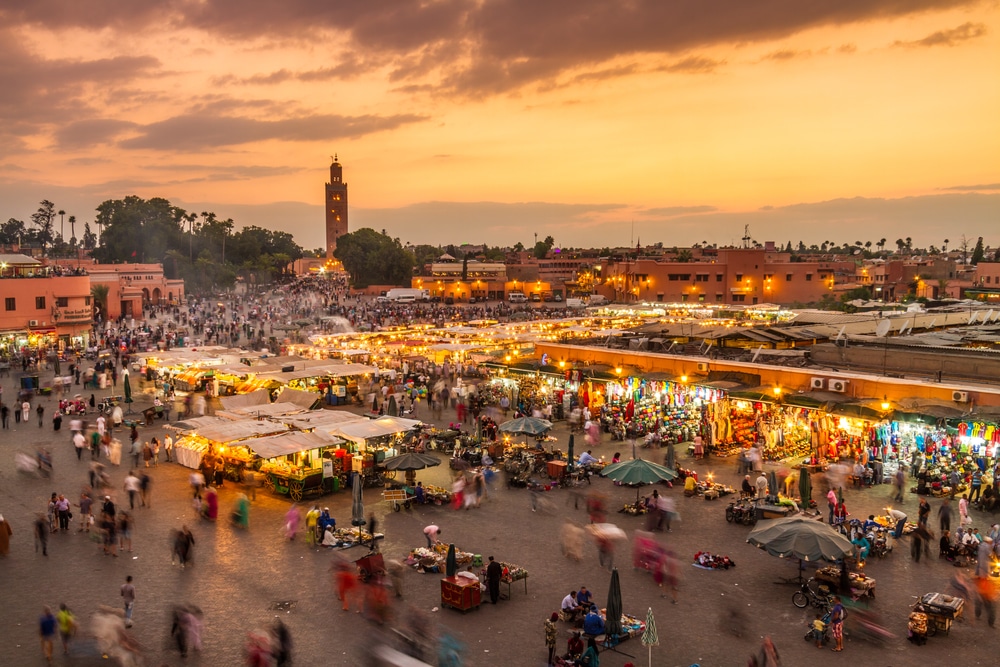The sky shines like a mystical lapis lazuli, and the snow-capped peaks of the High Atlas shimmer on the distant horizon. Holidaymakers in Morocco rave about the magic of this North African light and the sensuality of the Orient. In the bazaars of the Berber cities it smells of cinnamon and saffron and between the old walls acrobats, snake charmers, shoe shiners and the sellers of melons find their stages and their audience.
This country, south of the Strait of Gibraltar , professes moderate Islam and a constitutional monarchy with a king from the Alawite dynasty. It is a country bordered by the infinity of the Sahara but also by the Mediterranean Sea and the Atlantic Ocean. Since Morocco has a long history of tourism, it is recommended as an exceptional destination.

In front of the medina, the carriages, the traditional means of transport of Morocco’s historic cities, are waiting. Behind panting horses, you carefully walk through the labyrinth of this oriental picture-book splendour. Morocco serves its guests the fascination of the imperial cities on a silver platter, so to speak, and if you don’t get lost in the maze of alleys of the souks, you will enjoy this atmosphere with all your senses.
Marrakech, Fez, Meknes, Casablanca and Rabat are the cornerstones of Moroccan history, stone witnesses of a great past and at the same time pearls of the present.
All of them were capitals of the North African country in different periods of history, and their respective rulers were apparently overwhelmed by the ambition to leave behind something significant for posterity. Anyone who strolls through these cities, which are so different in their building fabric, today embarks on a journey through time and space and walks in the footsteps that UNESCO has declared a World Heritage Site.
Fez sees itself immodestly as the memory of the Moroccan nation, because the metropolis has a wealth of art treasures like hardly any other oriental city. Since the late 8th century AD, there have been no wars here. Fez is the work of Prince Idriss I, who, according to Islam, was a descendant of the Prophet Muhammad. The Karawijin Mosque can accommodate 20,000 worshippers for their prayers. Affiliated with it is the oldest university in the Muslim world.

The Qur’anic writings are also studied in the Koranic schools of Marrakech. This is a mysterious royal city on the edge of the desert and with the Square of the Jugglers as the lively center. When the heat of the day evaporates and the coolness of the evening also beguiles the senses of the holidaymakers, the scent of the numerous food stalls hangs over the city.
Meknès impresses with a forty-kilometre-long and almost intact city wall, the shady parks and the government palace. Rabat is the traditional “white royal city” and has been the residence of the Alawite dynasty for more than a hundred years. No metropolis in the north of the Black Continent has given itself such a modern coat of paint as Rabat with its covered souk Es Sebat.
If you decide to go on a tour to the nearby Sahara, you will soon notice that the heat sometimes leads to fallacies and that the horizon disappears into the pale nowhere. But the desert also has many faces in Morocco. There are the karstic mountain ranges with their serpentine roads that end at the top of the passes. But there are also the many oases with their proud date palms and sleepy-looking small villages.
Zagora was once a caravan station – the starting point for journeys through the infinity of the African north. Somewhere the holidaymaker finds the much-photographed sign “52 days to Timbuktu”. This signpost is probably also understood as a threat in the land of the Berbers and nomads. Anyone who not only feels the hot breath of the Sahara as a holidaymaker, but is lucky enough to witness the mystical atmosphere of the traditional “Guedra” in the light of a fire, will never forget this “dance of the desert”.
Travel information Morocco
| Capital | Rabat |
|---|---|
| Form of government | Hereditary Monarchy constitutional monarchy |
| Currency | Dirham (MAD) |
| Area | approx. 446,550 km² including Western Sahara: 710,850 km² |
| Population | approx. 35,740,000 (2017) |
| Languages | Arabic and Mazir (Berber) |
| Electricity grid | 127/220 volts, 50 Hz |
| Area code | +212 |
| Time zone | UTC±0 UTC+1 (March to October) |


